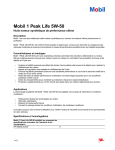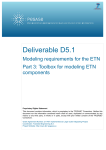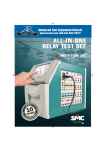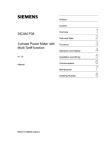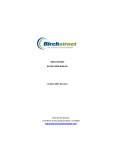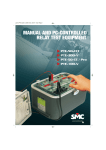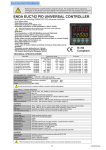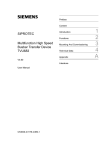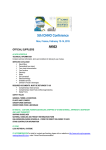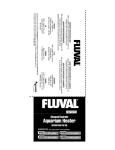Download "user manual"
Transcript
Scilab models for some protection and automation devices WP5 Proprietary Rights Statement This document contains information, which is proprietary to the "PEGASE" Consortium. Neither this document nor the information contained herein shall be used, duplicated or communicated by any means to any third party, in whole or in parts, except with prior written consent of the "PEGASE" Consortium. Grant Agreement Number: 211407 implemented as Large-scale Integrating Project Coordinator: GDF SUEZ Project Website: http://www.fp7-pegase.eu Document Information Document Name: Scilab models for some protection and automation devices ID: MIS_RTU_WP5_Scilab_Models_120110_V0.doc WP: 5 Task: Revision: 0 Revision Date: 10/01/2012 Author: V.Strelkovs Diffusion list Approvals Author Name Company V.Strelkovs RTU Date Visa Author Author Task Leader WP Leader Documents history Revision Date Modification Author 0 10/01/2012 First version of the document V.Strelkovs Date: 12/01/2012 Page: 2 MIS_RTU_WP5_Scilab_Models_120110_V0.doc Table of content Scilab models for some protection and automation devices ............................................... 1 WP5 1 1. Introduction ................................................................................................................ 4 2. Over-current (voltage, frequency, power etc.) protection ........................................... 5 3. Under-current (voltage, frequency, power etc.) protection ....................................... 10 4. Thermal overload protection .................................................................................... 12 5. References ............................................................................................................... 15 Date: 12/01/2012 Page: 3 MIS_RTU_WP5_Scilab_Models_120110_V0.doc 1. Introduction The purpose of the current report is to comply with the following recommendation by European Commission specified in the 2nd EC technical review: Recommendation 4: some of the models developed in Scilab under WP5 could be made available on the PEGASE website. It is considered reasonable to have a few representative models in open access version. Three models that are developed with open access software Scilab 5.3.3 (http://www.scilab.org/) are presented in the report. These models are applicable for a wide range of protective relaying functions. Date: 12/01/2012 Page: 4 MIS_RTU_WP5_Scilab_Models_120110_V0.doc 2. Over-current (voltage, frequency, power etc.) protection When a fault occurs in a power system, the fault current is almost always greater than the prefault load current in any power system element. A very simple and effective relaying principle is the one using current magnitude as an indicator of a fault. Over-current relays can be applied to protect practically any power system element, i.e. transmission lines, transformers, generators, or motors. The operating principle of a relay can be defined as follows [1]: I Iset. Trip I Iset. Do not trip (2.1) The quantity Iset. is known as the pickup setting of the relay. Equation (2.1) describes an ideal relay operating characteristic as shown in Figure 2.1. The relay does not operate (operating time is infinite) as long as current magnitude is less than Iset. If current magnitude exceeds Iset. , relay operates taking a definite time delay to close its contacts. T Operating zone t> t>> I> I>> I Figure 2.1: Example of tripping characteristic of two-stage over-current protection function The same operation principle is true for other input signals as well: Current (positive seq., negative seq., zero seq., residual), Voltage (phase, line, positive seq., negative seq., zero seq., residual), Frequency (frequency, rate of change of frequency), Power (active, reactive, apparent, positive seq., negative seq., zero seq., 1-phase, 3phase), Speed, Etc. Let us add some typical requirements to the previously mentioned operating principles so that the developed model imitates more precisely real-world devices. Fixed length of tripping impulses Date: 12/01/2012 Page: 5 MIS_RTU_WP5_Scilab_Models_120110_V0.doc It is advisable to avoid inconsistent length of tripping impulses and to provide the possibility to define their length. In practice the trip command duration must be set longer than the maximum time taken by the circuit breaker to trip following initiation of a trip command (time from start of trip command until circuit breaker auxiliary contacts indicate that the circuit breaker is open). Cascaded events The model should be able to operate in case of cascaded (consecutive) events. Pick-up/drop-out ratio Pickup of the relay can be stabilized by setting the dropout value (the pickup condition is maintained until the signal falls below the drop-out value, thus securing that the function does not drop-out too fast) [2, 3, 4, 5]. The hysteresis or difference between pick-up and drop-out signals results in operation that is similar to a Schmitt trigger. Pick-up and drop-out ratio varies widely from relay to relay, and is settable or specified by manufacturers. Drop-out ratio is mostly around 0.95 for new digital protection devices. For older electromechanical devices it is lower, for instance, 0.8. Blocking/releasing input Very often protection is blocked or released according to some external criterion. Protection can be blocked in case of power swings or during automatic re-closure cycle. It can be released, for instance, if voltage decreases below a preset value (very often it is employed for over-current protection). To account for these blocking/releasing schemes it is necessary to supplement the model with digital blocking and releasing inputs. Previously mentioned operating principles and requirements are implemented in the model that is presented in Figure 2.2 with the description of individual blocks in Table 2.1. The presented model is relatively simple yet it is multi-purpose and can be applied in a number of simulation scenarios: 1) It can be applied as over-current/over-load protection for different power system elements – transformers, lines, generators, busbars, etc. 2) Wide range of other input quantities are applicable as well, therefore many protection functions can be modeled. 3) Two or more operating stages can be easily simulated applying several separate models, each for one stage. 4) It can be used as 1-phase, 2-phase, or 3-phase protection (respectively employing 1, 2, or 3 models). 5) The protection operation can be instantaneous (by setting time delay = 0) or time delayed. 6) Output signal can be applied for circuit breaker tripping as well as for alarming, releasing, and blocking purposes. Date: 12/01/2012 Page: 6 MIS_RTU_WP5_Scilab_Models_120110_V0.doc 7) Model can be used as a building block for complex protection and automation/SPS schemes that involve over-current (over-voltage, over-frequency, etc.) criterion. 8) It is applicable for all time scales – steady state, quasi steady state, transient, and dynamic. 9) It is applicable for different objectives – for off-line and real-time studies of the ETN, as well as for dispatcher training simulations. Figure 2.2: Block diagram of over-current (voltage, frequency, power, etc.) protection Date: 12/01/2012 Page: 7 MIS_RTU_WP5_Scilab_Models_120110_V0.doc Block number Description [6] 1. Input signal – current, voltage, frequency, power, etc. 2. The hysteresis block for pick-up and drop-out settings. As soon as monitored signal exceeds pick-up value, binary “1” value appears at the output of the hysteresis element (relay picks up). On the other hand – relay drops out as soon as signal decreases below drop-out value. 3 The switch block passes through the first (top) input or the third (bottom) input based on the value of the second (middle) input. 4 Constant “1” is chosen so that the numerical value of the output of the integrator 6 corresponds to the time that has passed since the start of the integration process. 5 Constant “-9999” is necessary to reset quickly the integrator 6 to zero. 6 This block is an integrator. The output “y” is the integral of the input “u” at the current time step “t”. Upper and lower limits can be set. Together with 3, 4 and 5 elements it forms resettable integrator. 7 This block performs logical comparison of its two inputs. 8 Time delay setting of the protection. 9 If the releasing input is not used then the binary “1” is connected to the second logical operator. 10 Blocking input is supplemented with logical “NOT” operator so that received binary “0” corresponds to “no blocking” state. 11 12 The logical operator block performs the specified logical operation on its inputs. If pick-up condition is maintained for a time period equal or greater than the time delay setting 8, the binary “1” value appears at the output of the logical operator (relay trips). Otherwise the output of resettable integrator 6 does not reach in time the value corresponding to the time delay setting 8. 13 The block performs addition of its inputs. 14 The hysteresis element 14 is intended to hold output signal for a fixed amount of time. Hysteresis element is switched off at -0.5. The switch off is achieved by the help of resettable integrator 18. 15 Constant “1”. 16 The switch block. 17 Constant “-9999”. 18 This block is an integrator. Together with 15, 16 and 17 elements it forms resettable integrator. 19 This block performs logical comparison of its two inputs. 20 Minimum trip signal duration setting. 21 The unique output of this block generates a regular train of events that are scheduled by parameter “period” in seconds. The starting date of events generation can be set in seconds with the “initialization time” parameter. 22 The scope block displays its input with respect to simulation time. Table 2.1: Description of individual blocks Some additional possible applications of the considered model are presented below: Dynamic cold load pickup function Sometimes it may be necessary to dynamically increase the pick-up values if, during starting, certain elements of the system show an increased power consumption after a long period of zero voltage (e.g. air-conditioning systems, heating installations, motors). Thus, a general raise of Date: 12/01/2012 Page: 8 MIS_RTU_WP5_Scilab_Models_120110_V0.doc pick-up thresholds can be avoided taking such starting conditions into consideration. A number of manufacturers have implemented such feature in their relays [2, 3, 4, 5]. The dynamic cold load pick-up feature can be simulated by blocking one over-current protection model and releasing the other when necessary. Switch-onto-fault (SOTF) logic The instantaneous high-current switch-onto-fault protection function is usually provided to disconnect immediately and without delay feeders that are switched onto a high-current fault. It is primarily used as fast protection in the event of energizing the feeder while the earth switch is closed, but can also be used every time the feeder is energized - in other words also following automatic re-closure [2, 3, 4, 5]. If necessary, the SOTF function can be easily modeled by releasing for a short period of time the over-current protection model during feeder energization. Date: 12/01/2012 Page: 9 MIS_RTU_WP5_Scilab_Models_120110_V0.doc 3. Under-current (voltage, frequency, power etc.) protection These protections are used to protect equipment against an abnormally low current (voltage, frequency, etc.). They can also be used, for instance, [1]: • To monitor the operation of voltage regulators, • To load shed the non-priority consumer network when an overload occurs, • To monitor the voltage before sources to carry out a power supply transfer. The protection in its simplest form is activated when the input signal decreases below the pre-set threshold. Suggested block diagram of under-current (voltage, frequency, etc.) protection is presented in Figure 3.2. When modeling this type of protection it should be noted that the drop-out setting of the protection has larger value than the pick-up setting, therefore standard hysteresis (Schmidt trigger) element cannot be applied. In order to model the pick-up/drop-out feature the logic depicted in Figure 3.1 can be used – if the operating point is below pick-up setting, then “+2” is set at the output of the block 12 in Figure 3.2 and the relay picks up. If operating point is above the drop-out setting, then “-2” is set and the relay drops out. In case of “0” relay waits for further signal changes. The rest of the model is the same as in previous chapter. Figure 3.1: Pick-up and drop-out moments during transient process Date: 12/01/2012 Page: 10 MIS_RTU_WP5_Scilab_Models_120110_V0.doc Figure 3.2: Block diagram of under-current (voltage, frequency, power etc.) protection Date: 12/01/2012 Page: 11 MIS_RTU_WP5_Scilab_Models_120110_V0.doc 4. Thermal overload protection Overloading transmission lines, cables, transformers, generators, motors, etc. beyond the nameplate rating can cause a rise of temperature of these devices above permissible level. As a result the insulation will deteriorate, resulting in accelerated loss-of-life of the equipment. The thermal overload protection is used to avoid it [1, 7]. Thermal overload function is available in modern numerical protection relays. This function, depending on the protected object and specific implementation in the relay, uses some combination of ambient temperature, oil temperature, and measured current, to detect the presence of an over-temperature condition. The block diagram of thermal overload protection is presented in Figure 4.1. Most of it is similar to the diagrams discussed in previous sections (except that it has additional alarm stage). The first part of diagram models the heating equation (4.1): I dH H dt Imax 2 (4.1) where: Symbol Unit Description H [%] Heat rise. For example, if H = 120%, the oil or winding of the protected object overheat by 20% in relation to its nominal operation. I [A] Actual load current. Imax [A] Maximum permissible current or “full load current”. T [min] Thermal time constant of the protected object. Equation (4.1) is in accordance with IEC 60255-8 [8] and is used to track a first-order thermal image (replica) based on the measured current. The thermal replica model calculates a maximum temperature rise based on the measured current, the thermal time constant, and the maximum permissible current of the protected object. The biggest advantage of using a thermal replica for temperature protection is the ease of implementation. The function involves only settings in the relay, with no need to physically install and connect temperature sensors. However, this method does not account for ambient temperature, and provides only a simple representation of oil or winding temperatures due to load, but is not truly the temperature of interest (oil, top-oil, winding, or hot-spot temperature). Functionally, therefore, this is essentially an over-current function, with an asymptotic time delay. Thermal replica based protection elements typically include several threshold settings, to alarm and trip on increasing temperature conditions. The thermal replica model is widely used, it is incorporated in many protection devices by different manufacturers and it can be applied to different power system elements. Date: 12/01/2012 Page: 12 MIS_RTU_WP5_Scilab_Models_120110_V0.doc Protection tripping time can be easily calculated (for model verification purposes only), assuming the protected object is loaded with constant current I (4.2) [1, 7, 8]: I 2 Hinit Imax t trip ln [min] 2 I 1 I max (4.2) The calculated value will show how much time has left until the actual heat content H will exceed the set overload level H trip ( H trip = 100 %). In a similar way as with the protection tripping time, the alarm time can be estimated (4.3): I 2 H init I max t alarm ln [min] 2 I H alarm I max (4.3) The calculated value will show how much time has left until the actual heat content H will exceed the set alarm level H alarm ( H alarm = 80 %, for instance), assuming that the load current I will remain constant. The calculation of the heat content “H” is based on the fact that the temperature in the windings or oil is proportional to the square of the current, and that the temperature increases and decreases exponentially with a certain time constant [1, 2, 3, 4]. The part of the model that represents the equation (4.1) includes blocks 1 to 8 (see Figure 4.1). Date: 12/01/2012 Page: 13 MIS_RTU_WP5_Scilab_Models_120110_V0.doc Figure 4.1: Block diagram of thermal overload protection Date: 12/01/2012 Page: 14 MIS_RTU_WP5_Scilab_Models_120110_V0.doc 5. References [1] Christophe Preve, “Protection of Electrical Networks,” ISTE Ltd., 2006. ISBN-10: 1905209-06-1. [2] SIPROTEC Multi-Functional Protective Relay with Local Control 7SJ62/64 V4.7, Manual, Siemens. [3] MiCOM P141, P142, P143 Feeder Management Relays, Technical Guide, Areva. [4] F650 Digital Bay Controller, User manual, Firmware version: 3.7X, GE Multilin, 2007. [5] MiCOM P125, P126, P127 Directional/Non-directional Relay, Version 6D, Technical Guide, Areva. [6] Scilab v5.3.3 Help. [7] Rich Hunt, Michael L. Giordano, "Thermal Overload Protection of Power Transformers - Operating Theory and Practical Experience," 59th Annual Protective Relaying Conference, Georgia Tech, Atlanta, Georgia, April 27th - 29th, 2005. [8] IEC 60255-8 Electrical Relays - Thermal Electrical Relays, Second Edition, 1990. Date: 12/01/2012 Page: 15 MIS_RTU_WP5_Scilab_Models_120110_V0.doc















